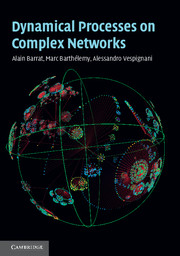Book contents
- Frontmatter
- Contents
- Preface
- Acknowledgements
- List of abbreviations
- 1 Preliminaries: networks and graphs
- 2 Networks and complexity
- 3 Network models
- 4 Introduction to dynamical processes: theory and simulation
- 5 Phase transitions on complex networks
- 6 Resilience and robustness of networks
- 7 Synchronization phenomena in networks
- 8 Walking and searching on networks
- 9 Epidemic spreading in population networks
- 10 Social networks and collective behavior
- 11 Traffic on complex networks
- 12 Networks in biology: from the cell to ecosystems
- 13 Postface: critically examining complex networks science
- Appendix 1 Random graphs
- Appendix 2 Generating functions formalism
- Appendix 3 Percolation in directed networks
- Appendix 4 Laplacian matrix of a graph
- Appendix 5 Return probability and spectral density
- References
- Index
5 - Phase transitions on complex networks
Published online by Cambridge University Press: 05 September 2012
- Frontmatter
- Contents
- Preface
- Acknowledgements
- List of abbreviations
- 1 Preliminaries: networks and graphs
- 2 Networks and complexity
- 3 Network models
- 4 Introduction to dynamical processes: theory and simulation
- 5 Phase transitions on complex networks
- 6 Resilience and robustness of networks
- 7 Synchronization phenomena in networks
- 8 Walking and searching on networks
- 9 Epidemic spreading in population networks
- 10 Social networks and collective behavior
- 11 Traffic on complex networks
- 12 Networks in biology: from the cell to ecosystems
- 13 Postface: critically examining complex networks science
- Appendix 1 Random graphs
- Appendix 2 Generating functions formalism
- Appendix 3 Percolation in directed networks
- Appendix 4 Laplacian matrix of a graph
- Appendix 5 Return probability and spectral density
- References
- Index
Summary
Statistical mechanics has long studied how microscopic interaction rules between the elements of a system at equilibrium are translated into its macroscopic properties. In particular, many efforts have been devoted to the understanding of the phase transition phenomenon: as an external parameter (for example the temperature) is varied, a change occurs in the macroscopic behavior of the system under study. For example, a liquid can be transformed into a solid or a gas when pressure or temperature are changed. Another important example of phase transition is by the appearance in various metallic materials of a macroscopic magnetization below a critical temperature. Such spontaneous manifestations of order have been widely studied and constitute an important paradigm of the emergence of global cooperative behavior from purely local rules.
In this chapter, we first recall some generalities and definitions concerning phase transitions and the emergence of cooperative phenomena. For this purpose we introduce the paradigmatic Ising model, which is a cornerstone of the statistical physics approach to complex systems and, as we will see in other chapters, is at the basis of several models used in contexts far from physics such as social sciences or epidemics. After a brief survey of the main properties of the Ising model, we show how the usual scenarios for the emergence of a global behavior are affected by the fact that the interactions between the microscopic elements define a complex network.
- Type
- Chapter
- Information
- Dynamical Processes on Complex Networks , pp. 92 - 115Publisher: Cambridge University PressPrint publication year: 2008



